CSC/ECE 506 Spring 2014/12b ds: Difference between revisions
No edit summary |
|||
| (10 intermediate revisions by 2 users not shown) | |||
| Line 1: | Line 1: | ||
== '''On-chip interconnects''' == | == '''On-chip interconnects''' == | ||
__TOC__ | __TOC__ | ||
[https://docs.google.com/document/d/1B_FUoiCFMDZcRK5_0XonguArVqDnYt-b75wm_t58DyQ/edit Instructions here] | |||
[http://wiki.expertiza.ncsu.edu/index.php/CSC/ECE_506_Spring_2013/12b_dj Last Years wiki page ] | |||
== Introduction == | == Introduction == | ||
| Line 195: | Line 201: | ||
[[File:Store_Forward.gif|700px|thumb|center|'''Store and Forward Routing Scheme''' ''M'' = packet size (in flits), ''t<sub>r</sub>'' = time of routing decision within one router during building a routing path, ''t<sub>w</sub>'' = intra-router switching latency once the router has made the routing decision and a path has been set up through the router, ''t<sub>m</sub>'' = inter-router channel latency. The transmission latency of a packet of ''M'' flits between two adjacent routers is ''Mt<sub>m</sub>'' seconds.(a) Routing decision is being made in the first router. (b) The packet is performing the first hop to the second router after has been copied to the output buffer of the first router. (c) The whole packet after the second hop.]] | [[File:Store_Forward.gif|700px|thumb|center|'''Store and Forward Routing Scheme''' ''M'' = packet size (in flits), ''t<sub>r</sub>'' = time of routing decision within one router during building a routing path, ''t<sub>w</sub>'' = intra-router switching latency once the router has made the routing decision and a path has been set up through the router, ''t<sub>m</sub>'' = inter-router channel latency. The transmission latency of a packet of ''M'' flits between two adjacent routers is ''Mt<sub>m</sub>'' seconds.(a) Routing decision is being made in the first router. (b) The packet is performing the first hop to the second router after has been copied to the output buffer of the first router. (c) The whole packet after the second hop.]] | ||
'''Communication Latency for Store and Forward Routing:''' | |||
A packet of length ''M'' transmitted to distance ''d'' takes time ''t<sub>SF</sub>'' as given below: | |||
<div class="center" style="width: auto; margin-left: auto; margin-right: auto;">''t<sub>SF</sub> = d(t<sub>r</sub> + (t<sub>w</sub> + t<sub>m</sub>)M)''</div> | |||
====[http://en.wikipedia.org/wiki/Cut-through_switching Cut-Through routing] or [http://en.wikipedia.org/wiki/Wormhole_switching Worm Hole routing]==== | ====[http://en.wikipedia.org/wiki/Cut-through_switching Cut-Through routing] or [http://en.wikipedia.org/wiki/Wormhole_switching Worm Hole routing]==== | ||
| Line 200: | Line 212: | ||
[[File:Cut_Through.gif|900px|thumb|center|'''Cut-Through Routing Scheme''' ''t<sub>r</sub>'' = time of routing decision within one router during building a routing path, ''t<sub>w</sub>'' = intra-router switching latency once the router has made the routing decision and a path has been set up through the router, ''t<sub>m</sub>'' = inter-router channel latency. (a) The header flit has moved into the output buffer of the first router. (b) The header has cut through into the second router while subsequent flits are following its path. (c) Pulling a chain of flits behind, the header has cut through into a router where its output buffer is reserved for another communication. (d) The whole chain of packet flits has contracted and the whole packet gets buffered in the first router releasing all previously allocated links. (e) Flit pipeline moving towards the destination.]] | [[File:Cut_Through.gif|900px|thumb|center|'''Cut-Through Routing Scheme''' ''t<sub>r</sub>'' = time of routing decision within one router during building a routing path, ''t<sub>w</sub>'' = intra-router switching latency once the router has made the routing decision and a path has been set up through the router, ''t<sub>m</sub>'' = inter-router channel latency. (a) The header flit has moved into the output buffer of the first router. (b) The header has cut through into the second router while subsequent flits are following its path. (c) Pulling a chain of flits behind, the header has cut through into a router where its output buffer is reserved for another communication. (d) The whole chain of packet flits has contracted and the whole packet gets buffered in the first router releasing all previously allocated links. (e) Flit pipeline moving towards the destination.]] | ||
'''Communication Latency for Cut Through Routing:''' | |||
A packet of length ''M'' transmitted to distance ''d'' takes time ''t<sub>CT</sub>'' as given below: | |||
<div class="center" style="width: auto; margin-left: auto; margin-right: auto;">''t<sub>CT</sub> = d(t<sub>r</sub> + t<sub>w</sub> + t<sub>m</sub>) + max(t<sub>w</sub> , t<sub>m</sub>)M''</div> | |||
====[http://en.wikipedia.org/wiki/Deterministic_routing Deterministic routing]==== | ====[http://en.wikipedia.org/wiki/Deterministic_routing Deterministic routing]==== | ||
| Line 249: | Line 267: | ||
This protocol was designed to address inefficient port allocation in the BLESS protocol. A permutation network directs deflected flits to free output ports. By limiting the requirements so that only that the highest-priority flit obtains its request, we can prevent livelock. In the case of contention, arbitration logic chooses a winning flit. It does this by choosing a single packet, and prioritize that packet globally above all other packets for long enough that its delivery is ensured. Every packet in the system eventually receives this special status, so every packet is eventually delivered (the Golden Packet scheme).[[#References|[11]]] | This protocol was designed to address inefficient port allocation in the BLESS protocol. A permutation network directs deflected flits to free output ports. By limiting the requirements so that only that the highest-priority flit obtains its request, we can prevent livelock. In the case of contention, arbitration logic chooses a winning flit. It does this by choosing a single packet, and prioritize that packet globally above all other packets for long enough that its delivery is ensured. Every packet in the system eventually receives this special status, so every packet is eventually delivered (the Golden Packet scheme).[[#References|[11]]] | ||
The following graph shows a performance comparison of buffered routing protocols with the buffered protocol:[[#References|[11]]] | |||
[[File:Bufferless.png|1900px|thumb|center|Performance statistics for Bufferless Routing protocols]] | [[File:Bufferless.png|1900px|thumb|center|Performance statistics for Bufferless Routing protocols]] | ||
| Line 353: | Line 371: | ||
[18] http://ieeexplore.ieee.org.prox.lib.ncsu.edu/xpls/icp.jsp?arnumber=5090624 | [18] http://ieeexplore.ieee.org.prox.lib.ncsu.edu/xpls/icp.jsp?arnumber=5090624 | ||
[19] Mikkel B. Stenssgard and Jens Sparso, [http://ieeexplore.ieee.org/xpl/login.jsp?tp=&arnumber=4492725&url=http%3A%2F%2Fieeexplore.ieee.org%2Fxpls%2Fabs_all.jsp%3Farnumber%3D4492725 ReNoC: A Network-on-Chip Architecture with Reconfigurable Topology], ''Second ACM/IEEE International Symposium on Networks on Chip'' | [19] Mikkel B. Stenssgard and Jens Sparso, [http://ieeexplore.ieee.org/xpl/login.jsp?tp=&arnumber=4492725&url=http%3A%2F%2Fieeexplore.ieee.org%2Fxpls%2Fabs_all.jsp%3Farnumber%3D4492725 ReNoC: A Network-on-Chip Architecture with Reconfigurable Topology], ''Second ACM/IEEE International Symposium on Networks on Chip'', 2008 | ||
==Quiz== | ==Quiz== | ||
Latest revision as of 01:30, 24 April 2014
On-chip interconnects
Introduction
The current trend in microprocessor design has shifted from extracting ever increasing performance gains from single core architecture to leveraging the power of multiple cores per die. This creates new challenges not present in single core systems. A multi-core processor must have a method of passing information between processing cores that is efficient in terms of power consumed, space used on die, and the speed at which messages are delivered. As physical wire widths are decreased and the number of wires is increased, the difference between gate delay and wire delay is exacerbated.[14] To combat these challenges, much research has been done in the area of on-chip networks.
There are numerous topologies and routing protocols that are implemented in order to achieve the best performance. These technologies range in implementation from extremely simple to remarkably complex. The efficacy of any combination of topology and routing protocol is highly dependent on the characteristics of the workload. As such, the simplicity and cost-effectiveness of a simple solution may not be ideal for a particular workload and likewise, a highly complex system may achieve sub-optimal performance for a workload where a simpler solution would have sufficed.
Background
On-chip interconnects are a natural extension of the high integration levels that nowadays are reached with multiprocessor integration.
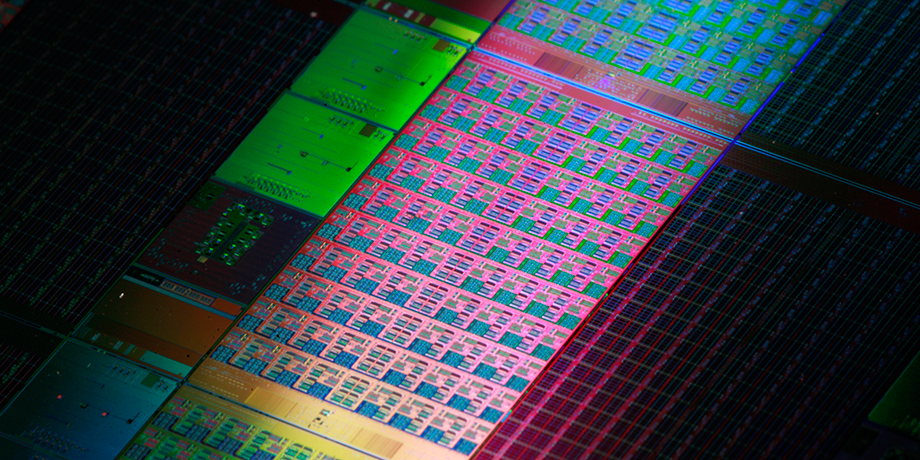
In recent years, the main players in the chip industry keep racing to provide more cores integrated in a chip, with the multi-core (more than one core) and many-core (multi-core with so many cores that the historical multi-core techniques are not efficient any longer) technologies. This integration is known as CMP (chip multiprocessor) and lately Intel has coined the term Intel® Many Integrated Core (Intel® MIC).
To make feasible the communication in between these many cores inside of a single chip, the traditional off-chip network has proved to have limited applications. According to [2], the off-chip designs suffered from I/O bottlenecks which are a diminished problem for on-chip technologies as the internal wiring provides much higher bandwidth and overcomes the delay associated with the external traffic. Nevertheless, the on-chip designs still have some challenges that need further study. Among some of these issues are power consumption and space constraints.
Terminology
An on-chip interconnect (or Network on Chip) is defined as:
A communication subsystem on an integrated circuit.
Some common terms:
- SoCs (Systems-on-a-chip), which commonly refer to chips that are made for a specific application or domain area.
- MPSoCs (Multiprocessor systems-on-chip), referring to a SoC that uses multi-core technology.
It is interesting to note that for the particular theme of this article, there are at least three different acronyms referring to the same term. These are new technologies and different researchers have adopted different nomenclature. The acronyms are:
- NoC (network-on-chip), this is the most common term and also used in this article
- OCIN (on-chip interconnection network)
- OCN (on-chip network)
Modern Implementations
Intel
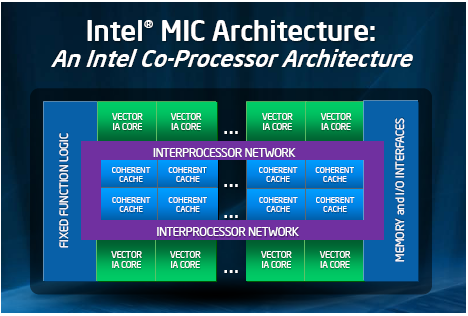
Intel's Many Integrated Core Architecture (Intel MIC Architecture) is an advanced design that combines many Intel CPU cores onto one single chip to achieve high supercomputing speed and performance. It allows developers to implement software platforms using standard programming tools and methods such as C, C++, and FORTRAN, and can execute trillions of calculations per second. In the MIC design, all the cores are communicated using a Message Parsing Interface, and interconnected using the Intel On-Chip System Fabric (IOSF), which is a proprietary chassis for its popular Atom computing platform [7] . The architecture of the IOSF lends itself to communication with traditional PCI buses, making it a viable technology for use in backwards-compatible general purpose computers. Additionally, through numerous licensing agreements, Intel has acquired the use of a wide variety of devices from graphics to modems and Wi-Fi Ethernet adapters. Coupled with the IOSF, conceivably entire computing platforms (SoCs) could be made at low cost and small footprint.
The Intel Xeon Phi family of processors are based on their MIC architecture. These co-processors offer up to 61 cores, 244 threads, and 16 GB of GDDR5 memory each. They offer up to 1.2 teraflops of double-precision performance.[17]
The Tianhe-2 supercomputer which become operational in June 2013, utilizes 16,000 computer nodes. Each node contains 3 Xeon Phi chips and two Ivy Bridge Xeon chips. As of Novemeber 2013, it was listed as the world's fastest supercomputer by the TOP500 list.
Tilera
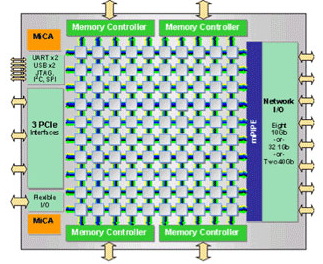
Tilera's new 40nm 64-bit 100-core processors chip, TILE-Gx100, claims the title for the most power-efficient processors in the world. The TILE-Gx100 processor can clock up to 1.5 GHz with only 48 Watt of power. Comparing with Intel's latest generation of Sandy Bridge processors, which range between 35W to 95W, the Gx 3100 only needs about half of the power to perform the same work. The technology behind this innovation is the iMesh™ on-chip network, which consists of five 8x8 independent mesh networks with two 32-bit unidirectional links per channel, and can provides a bisection bandwidth of 320GB/s. iMesh™ is built using the Tile Processor's architecture - an innovative implementation of on-chip networking using the 2D meshes. These are physically organized (as opposed to logically organized) due to design considerations when scaling and laying out new designs. Each tile of the Tile Processor is its own self-contained processor and can effectively function by itself; multiple processors can be combined to form an SMP system. The Tile Processor can be further enhanced by using its custom C language-based programming libraries (both POSIX threads and iLib), which fully leverage the processing capabilities of the CMP.
IBM
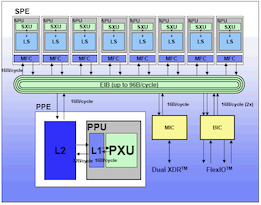
IBM's Cell architecture, also known as the Cell Broadband Engine Architecture (CBEA), is an innovative solution to providing power-efficient and cost-effective high-performance processing for a wind range of applications. It is a heterogeneous chip multiprocessor that consists of an IBM 64-bit Power Architecture™ core, which manages eight synergistic processing engines (SPEs) that can be used for floating-point calculations. These synergistic processors are interconnected using the Element Interconnect Bus (EIB), which allows for communication among the different components of the Cell, among them and with the external I/O. The Cell architecture is designed for data-intensive processing, such as cryptography, scientific, and media applications. As a curiosity, the Cell processor was jointly developed with Sony and Toshiba, and is used in the Sony PlayStation 3.
ST Microelectronics
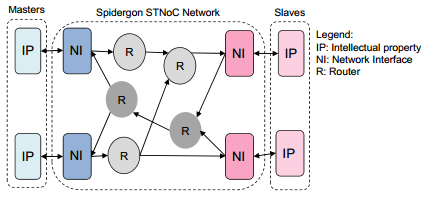
ST Microelectronics created the Spidergon[16] design for the STNoC [5]. The Spidergon is a pseudo-regular topology with a design that is composed of three building blocks: network interface, router, and physical link. These building blocks make the design ready to be tailored to the needs of the application. Each router building block has a degree of 3. The 3 building blocks can be used to create the specific design needed, with the input/output ports that the application requires. The blocks can be configured and stored in a library for creating the design. In the picture on the right, the example contains 2 of the building blocks (router and network interface) and a third undisclosed block.
ARM CoreLink Interconnect
The ARM CoreLink[15] Interconnect is a highly flexible and configurable interconnection network specification that implements the AMBA (Advanced Microcontroller Bus Architecture) protocol. The AMBA protocol is "an open standard, on-chip interconnect specification for the connection and management of functional blocks in a System-on-Chip (SoC). It enables development of multi-processor designs with large numbers of controllers and peripherals. [[http://www.arm.com/images/CoreLink_400_Series.jpg]]
Implementation Comparison
| Intel MIC | Tilera Tile-GX100 | IBM Cell | STMicro Spidergon | ARM Corelink |
| Message Passing | Message Passing | Shared Memory | Message Passing | Message Passing |
| IOSF Interconnect | iMesh Interconnect | Bus Interconnect | Spidergon Configurable Interconnect | Corelink Interconnect |
| High Performance | Low Power | High Performance | Configurable | Configurable |
Topologies
Topology refers to the layout or arrangement of interconnections among the processing elements. In general, a good topology aims to minimize network latency and maximize throughput. There are certain metrics that help with the classification and comparison of the different topology types. Some of them are defined in Solihin's [3] textbook in chapter 12.
- Degree is defined as the number of nodes that are neighbors to, or in other words, can be reached from it in one hop
- Hop count is the number of nodes through which a message needs to go through to get to the destination
- Diameter is the maximum hop count
- Path diversity is useful for the routing algorithm and is given by the amount of shortest paths that a topology offers between two nodes.
- Bisection width is the smallest number of wires you have to cut to separate the network into two halves
Topologies can be classified as direct and indirect topologies.
In a direct topology, each node is connected to other nodes, which are named neighbouring nodes. Each node contains a network interface acting as a router in order to transfer information.
In an indirect topology, there are nodes that are no computational but act as switches to transfer the traffic among the rest of the nodes, including other switches. It is called indirect because packets are switched through specific elements that are not part of the computational nodes themselves.
An example of direct topologies is 2-D Mesh. An example of indirect topology is Flattened Butterfly.
There are many different topologies that could be introduced in this section. Some of the missing topologies include but are not limited to:
- Hypercube
- Shuffle-exchange
- Torus
- Trees
They are just cited here for completion, related information can be found at Interconnection Networks
2-D Mesh
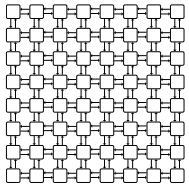
This has been a very popular topology due to its simple design and low layout and router complexity. It is often described as a k-ary n-cube , where k is the number of nodes on each dimension, and n is the number of dimensions. For example, a 4-ary 2-cube is a 4x4 2D mesh.
Another advantage is that this topology is similar to the physical die layout, making it more suitable to implement in tiled architectures. For reference, the combination of the switch and a processor is named tile.
But not everything are advantages in this topology. One of the drawbacks of 2D Meshes is that the degree of the nodes along the edges is lower than the degree of the central nodes. This makes the 2D Mesh asymmetrical along the edges, therefore from the networking perspective, there is less demand for edge channels than for central channels.
Jerger and Peh [2], provide the following information on parameters for a mesh as defined as a k-ary n-cube:
- the switch degree for a 2D mesh would be 4, as its network requires two channels in each dimension or 2n, although some ports on the edge will be unused.
- average minimum hop count:
nk/3 k even n(k/3-1/3k) k odd
- the channel load across the bisection of a mesh under uniform random traffic with an even k is k/4
- meshes provide diversity of paths for routing messages
Concentration Mesh
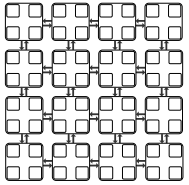
This is an evolution of the mesh topology. There is no real need to have a 1:1 relationship between the number of cores and the number of switches/routers. The Concentration mesh reduces the ratio to 1:4, i.e. each router serves four computing nodes.
The advantage over the simple mesh is the decrease in the average hop count. This is important in terms of scaling the solution. But it is not as scalable as it could seem, as its degree is confined to the crossbar complexity [1]
The reduction in the ratio introduces a lower bisection channel count, but it can be avoided by introducing express channels, as demonstrated in [4].
Another drawback is that the port bandwidth can become a bottleneck in periods of high traffic.
Flattened Butterfly

A butterfly topology is often described as a k-ary n-fly, which implies kn network nodes with n stages of kn−1 k × k intermediate routing nodes. The degree of each intermediate router is 2k.
The flattened butterfly is made by flattening (i.e. combining) the routers in each row of a butterfly topology while preserving the inter-router connections. It does non-minimal routing for load balancing improvement in the network.
Some advantages are that the maximum distance between nodes is two hops and it has lower latency and better throughput than that of the mesh topology.
For the disadvantages, it has high channel count (k2/2 per row/column), low channel utilization, and increased control complexity.
Multidrop Express Channels (MECS)
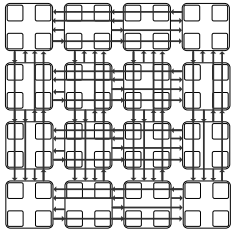
Multidrop Express Channels was proposed in [1] by Grot and Keckler. Their motivation was that performance and scalability should be obtained by managing wiring.
Multidrop Express Channels is defined by its authors as a "one to-many communication fabric that enables a high degree of connectivity in a bandwidth-efficient manner." Based on point-to-point unidirectional links. This makes for a high degree of connectivity with fewer bisection channels and higher bandwidth for each channel.
Some of the parameters calculated for MECS are:
- Bisection channel count per each row/column is equal to k.
- Network diameter (maximum hop count) is two.
- The number of nodes accessible through each channel ranges from 1 to k − 1.
- A node has 1 output port per direction
- The input port count is 2(k − 1)
The low channel count and the high degree of connectivity provided by each channel increase per channel bandwidth and wire utilization. At the same time, the design minimizes the serialization delay. It presents low network latencies due to its low diameter.
Comparison of topologies
This data is taken from the analysis done in [1]. The following table shows comparison of CMesh, Flattened Butterfly, and MECS topologies:
| CMesh | Flattened Butterfly | MECS | |||||||
| k-network radix c-concentration α-VCs per port |
k=4 c=4 α=8 |
k=8 c=4 α=8 |
k=4 c=4 α=1 |
k=8 c=4 α=1 |
k=4 c=4 α=1 |
k=8 c=4 α=1 | |||
| Max Hop Count | 2k-1 | 7 | 15 | 2 | 2 | 2 | 2 | 2 | 2 |
| Bisection Channels (per direction) |
1 | 1 | 1 | k2/4 | 4 | 16 | k/2 | 2 | 4 |
| BW/Channel | B | B | B | 4B/k2 | B/4 | B/16 | 2B/k | B/2 | B/4 |
The information in this table compares three of the topologies described above for two combinations of k which is the network radix (nodes/dimension) and c (concentration factor, 1 being no concentration). Maximum hop count is 2 for flattened butterfly and MECS, whereas is directly proportional to k in the case of Concentrated Mesh, what makes flattened butterfly and MECS better solutions with less network latency. The bisection channels is 1 for CMesh in both cases, but it gets doubled and even quadrupled between MECS and flattened butterfly. The bandwidth per channel in this example is better for CMesh and MECS, getting attenuated in the case of flattened butterfly.
| Name | Application Size |
Total Size | Description | |
| "Tiny" | AtAllPut SumTo Recur Tak |
3 3 3 10 |
1059 1049 1047 1055 |
store 7 into all elements of 100000 element vector sums all integers between 1 and 10000; repeated 100 times tiny recursive benchmark derived from Tak benchmark in the Gabriel Lisp benchmark suite |
| "Small" | Bubble Detabify Intmm Mergesort Perm Puzzle Queens Quick Quick2 Sieve Towers Tree |
20 21 30 50 25 170 35 35 35 25 60 25 |
1089 1071 1092 1169 1082 1309 1094 1101 1180 1053 1116 1108 |
sort an array of 5000 numbers with Bubblesort replace tabs by blanks in a string of ASCII characters 40x40 integer matrix multiply sorts a 20000 element array of integers using Mergesort heavily recursive permutation program solves a tile placement problem solves the eight queens placement problem 50 times sort an array of 5000 numbers with Quicksort like quick, but written in an object oriented style computes prime numbers using sieve of Erastothenes solves Towers of Hanoi problem for 14 disks sorts 5000 random integers by inserting them into a sorted binary tree |
| "Large" | DeltaBlue Diff SParser PrimMaker Richards RSA CParser |
500 300 400 1100 400 300 7000 |
1358 1992 1442 2241 1284 1541 10984 |
DeltaBlue constraint solver compares two files using the same algorithm as the Unix diff utility parser for the SELF-89 language generates SELF and C glue stubs from a description of external C functions simulates a simple operating system public key encryption and key computation (uses BigIntegers) parser for ANSI C; includes lexer, LALR(1) parser, and tree builder |
Routing
There are a variety of routing protocols that can be used for SoC's, each having different advantages and disadvantages. They can be broadly classified into several different categories.
General Routing Schemes
Store and forward routing
This routing scheme has been used since the early days of communications. It requires that the entire message be received at a node prior before it is propagated to the next node. This protocol suffers from a high storage requirement and high latency, due to the need to completely buffer a message before forwarding it.[7] This approach can be quite effective when the average packet size is small in comparison with the channel widths.

Communication Latency for Store and Forward Routing:
A packet of length M transmitted to distance d takes time tSF as given below:
Cut-Through routing or Worm Hole routing
These two protocols use the switch to examine the flit header, decide where to send the message, and then start forwarding it immediately. True cut-through routing lets the tail continue when the head is blocked, stacking message packets into a single switch (which requires a buffer large enough to hold the largest packet). In worm hole routing, when the head of the message is blocked the message stays strung out over multiple nodes in the network, potentially blocking other messages (however, this needs only enough buffer space to store the piece of the packet that is sent between switches). Using a cut-through protocol lowers latency but can suffer from packet corruption and must implement a scheme to handle this.[7]
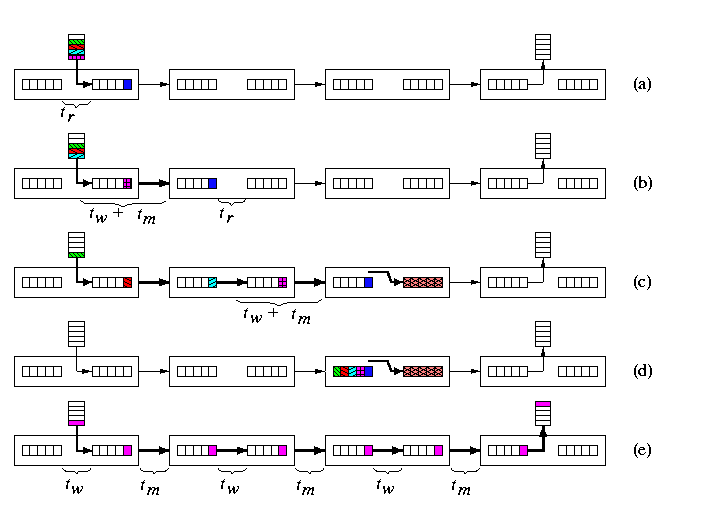
Communication Latency for Cut Through Routing:
A packet of length M transmitted to distance d takes time tCT as given below:
Deterministic routing
This describes a routing scheme where, if we are given a pair of nodes, the same path will always be used between those nodes. It involves switching in which the routes between given pairs of nodes are pre-programmed, i.e., are determined, in advance of transmission. There are routing tables maintained in each switch database for this purpose. In case of failure of a switch responsible for transmission, the message cannot be resent till a new route is manually programmed in the switch database.
Adaptive routing
This is a routing scheme where the underlying routers may alter the path of packet flow in response to system conditions or other algorithm criteria. Adaptive routing is intended to provide as many routes as possible to reach the destination. Even in case of failure of one of the switches, a new route is dynamically selected by the network allowing successful transmission of the packet.
Deadlock and Livelock
Deadlock and Livelock are two separate situations that may occur during routing, both resulting in packets never reaching their destination. They are defined as follows:
Deadlock is defined as a situation where there are activities (e.g., messages) each waiting for another to finish something.[8] Since a waiting activity cannot finish, the messages are deadlocked. This is analogous to the Dining Philosophers Problem, each deadlocked message is waiting on the result of another deadlocked message, none of which are able to reach their destination.
Livelock is defined as a situation where a message can move from node to node but will never reach their destination node.[8] This is similar to deadlock in that the message never reaches its destination, but the message is still able to travel through portions of the network, making hops but never reaching its target. This is analogous to a process spinning while waiting, the process itself is doing meaningless work but it is still active. Livelock is a risk with some routing algorithms that detect and recover from deadlock. If more than one of the switches involved takes action, the deadlock detection algorithm can be repeatedly triggered. This can be avoided by ensuring that only one switch (chosen randomly or by priority) takes action in response to deadlock detection.
Routing Protocols in SoC's
The specific routing protocols below are built using the ideas from the classes of protocols previously described.
Source Routing
The source node partially or totally computes the path a packet will take through the network and stores the information in the packet header. The extra route information is sent in each packet, inflating their size. Source routing protocols make troubleshooting the network and extracting route information (traceroute) easier. Strict Source Routing (SSR) is an algorithm where the sender specifies the exact route the packet must take. This is virtually never used because of the above mentioned limitations of Deterministic routing. The more common form is Loose Source Record Route (LSRR), in which the sender gives one or more hops that the packet must go through.
Scalable Source Routing and Dynamic Source Routing are ad-hoc extensions that use source routing with some other dynamic routing protocol to get increased throughput.
Distributed Routing
Each switch in the network computes the next route that will be taking towards the destination. The packet header contains only the destination information, reducing its size compared to source routing. This approach requires routing tables to be present to direct the packet from node to node, which does not scale well when the number of nodes increases.
Logic Based Distributed Routing (LBDR)
In this protocol, routing is achieved by each router knowing its position in the architecture and being able to determine what direction it is from the destination of the packet. It is most commonly used in 2D meshes, but it can be applied to other topologies as well.[7] Using this position information, it is possible to route the packet based on a small number of bits and a few logic gates per router, which saves over a table or a buffer.
There are several variations of LBDR
LBDRe - This variation models up to two future hops before deciding where to send the packet next.
uLBDR (Universal LBDR) - This variation adds packet multicast support to the protocol.
bLBDR - This variation adds the ability to broadcast messages to only certain regions (segments) of the network.
Bufferless Deflection Routing (BLESS protocol)
In this protocol, each flit of a packet is routed independently of every other flit through the network, and different flits from the same packet may take different paths. Any contention between multiple flits results in one flit taking the desired path and the other flit being “deflected” to some other router. This may result in undesirable routing, but the packets will eventually reach the destination.[10] This type of routing is feasible on every network topology that satisfies the following two constraints: Every router has at least the same number of output ports as the number of its input ports, and every router is reachable from every other router.[10]
CHIPPER (Cheap-Interconnect Partially Permuting Router)
This protocol was designed to address inefficient port allocation in the BLESS protocol. A permutation network directs deflected flits to free output ports. By limiting the requirements so that only that the highest-priority flit obtains its request, we can prevent livelock. In the case of contention, arbitration logic chooses a winning flit. It does this by choosing a single packet, and prioritize that packet globally above all other packets for long enough that its delivery is ensured. Every packet in the system eventually receives this special status, so every packet is eventually delivered (the Golden Packet scheme).[11] The following graph shows a performance comparison of buffered routing protocols with the buffered protocol:[11]
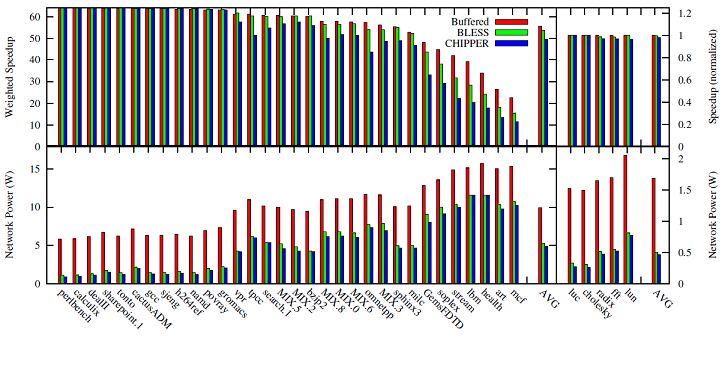
Dimension-order Routing
This protocol is a deterministic strategy for multidimensional networks. Each direction is chosen in order and routed completely before switching to the next direction. For example, in a 2D mesh, dimension order routing could be implemented by completely routing the packet in the X-dimension before beginning to route in the Y-dimension. This is extensible to higher order connections as well, for example, hypercubes can be routed in dimension order by routing packets along the dimensions in the order of different bit positions of the source and destination address, one bit position at a time.[9]
Design Considerations
Energy Consumption
Multi-processor SoCs require additional energy in order to operate the on-chip interconnection hardware like routers. Too, the links between components can introduce increased losses in regards to required voltages and physical arrangement. Indeed, "on-chip network power has been estimated to consume up to 28% of total chip power" due to "channels, router fifos and router crossbar fabrics". Simple topologies use less power due to simpler routers, but the increased number of hops can lead to overall increased power consumption.
Scalability
Scalability ties back to both energy and cost, but also to engineering constraints as well. Specifically, the architecture needs to be sensitive to the power and heat requirements of the design, as well as the physical die size. Further, the design requires the ability to be fabricated predictably and within reasonable costs. To mitigate some of these factors, concentration of network interfaces can be employed, where a network interface is shared by multiple terminals. Efforts to scale more complicated topologies like the butterfly (into a "flattened" butterfly) have yielded promising results, but at the expense of too much energy expenditure.
Lines of Research
From NoCs perspective, there are many lines of research besides the abundant of technologies of the commercial designs. Some of them are presented in this section.
Optical on-chip interconnects
IBM has been performing extensive research on photonic layer inside of the CMP used not only for connecting several cores, but also for routing traffic: Silicon Integrated Nanophotonics. This technology was actually used in the IBM Cell chip that was mentioned in above sections. The main advantages are reliability and power efficiency.
This tutorial explains some differences between electronics and photonics in terms of power consumption, the more efficient is the computing from power's perspective, the more FLOPs per Watt:
| Electronics | Photonics |
| Electronic network ~500W | Optic network <80W |
| power = bandwidth x length | power does not depend on bitrate nor length |
| buffer on chip that rx and re-tx every bit at every switch | rx (modulate) data once, without having to re-tx |
| switching fabric has almost no power dissipation |
This shows how a simple optical switch works in conjunction with a microresonator(MR). While the MR is off, the input follows the through line. While the MR is on, the input follows the drop line.[18]
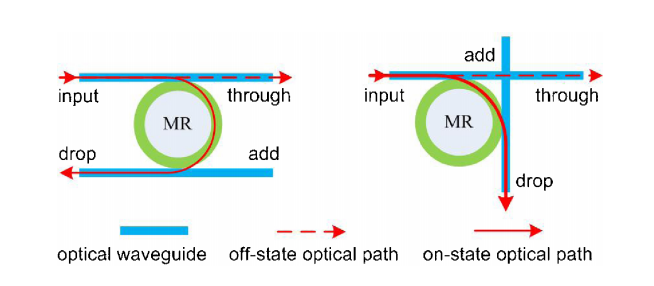
In academia, there are articles like [6] which proposes a new topology created for optical on-chip interconnects. They refer to previous papers that cite adaptations of well-known electronic designs, but highlight the need to provide a "scalable all-optical NoC, referred to as 2D-HERT, with passive routing of optical data streams based on their wavelengths."
Reconfigurable NoC
Another field of study is the Software reconfigurable on-chip networks. They are commonly based on the 2D mesh topology. The main idea is to be able to reconfigure the NoC depending on the application and during run-time to react to congestion problems or, in general, adapt to the traffic load. An example of dynamically reconfigurable topology is demonstrated below:[19]
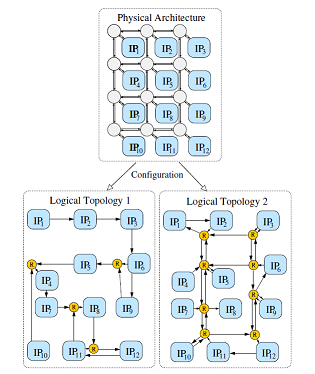
In [12], the authors propose a design based on the properties of the field-programmable gate array (FPGA). It can dynamically implement circuit-switching channels, perform variations in the topology, and reconfigure routing tables. One of the main drawbacks is the overhead that this reconfiguration introduces, although it is designed to minimize it.
Bio NoC
Bio NoC or ANoC (Autonomic Network-on-Chip) is based on the concept of the human autonomic nervous system or the human biological immune system. The intention is to provide a NoC with self-organization, self-configuration, and self-healing to dynamically control networking functions.
[13] presents a collection of chapters/articles from emerging research issues in the ANoC field of application.
Recommended Readings
[1] Mirza-Aghatabar, M.; Koohi, S.; Hessabi, S.; Pedram, M.; , "An Empirical Investigation of Mesh and Torus NoC Topologies Under Different Routing Algorithms and Traffic Models," Digital System Design Architectures, Methods and Tools, 2007. DSD 2007. 10th Euromicro Conference on , vol., no., pp.19-26, 29-31 Aug. 2007
[2] Ying Ping Zhang; Taikyeong Jeong; Fei Chen; Haiping Wu; Nitzsche, R.; Gao, G.R.; , "A study of the on-chip interconnection network for the IBM Cyclops64 multi-core architecture," Parallel and Distributed Processing Symposium, 2006. IPDPS 2006. 20th International , vol., no., pp. 10 pp., 25-29 April 2006
[3] David Wentzlaff, Patrick Griffin, Henry Hoffmann, Liewei Bao, Bruce Edwards, Carl Ramey, Matthew Mattina, Chyi-Chang Miao, John F. Brown III, and Anant Agarwal. 2007. On-Chip Interconnection Architecture of the Tile Processor. IEEE Micro 27, 5 (September 2007), 15-31.
[4] D. N. Jayasimha, B. Zafar, Y. Hoskote. On-chip interconnection networks: why they are different and how to compare them. Technical Report, Intel Corp, 2006
[5] John Kim, James Balfour, and William Dally. Flattened butterfly topology for on-chip networks. In Proceedings of the 40th International Symposium on Microarchitecture, pages 172–182, December 2007.
References
[1] B. Grot and S. W. Keckler. Scalable on-chip interconnect topologies. 2nd Workshop on Chip Multiprocessor Memory Systems and Interconnects, 2008.
[2] Natalie Enright Jerger and Li-Shiuan Peh. On-Chip Networks. Synthesis Lectures on Computer Architecture. 2009, 141 pages. Morgan and Claypool Publishers.
[3] Yan Solihin. (2008). Fundamentals of parallel computer architecture. Solihin Pub.
[4] James Balfour and William J. Dally. 2006. Design tradeoffs for tiled CMP on-chip networks. In Proceedings of the 20th annual international conference on Supercomputing (ICS '06). ACM, New York, NY, USA, 187-198.
[5] Dubois, F.; Cano, J.; Coppola, M.; Flich, J.; Petrot, F.; , Spidergon STNoC design flow, Networks on Chip (NoCS), 2011 Fifth IEEE/ACM International Symposium on , vol., no., pp.267-268, 1-4 May 2011
[6] Koohi, S.; Abdollahi, M.; Hessabi, S.; , All-optical wavelength-routed NoC based on a novel hierarchical topology, Networks on Chip (NoCS), 2011 Fifth IEEE/ACM International Symposium on , vol., no., pp.97-104, 1-4 May 2011
[7] Flich, J.; Duato, J.;, Logic-Based Distributed Routing for NoCs, 2008 Computer Architecture Letters, vol. 7, no. 1, pp.13-16, Jan 2008
[8] Wu, J.; A Fault-Tolerant and Deadlock-Free Routing Protocol in 2D Meshes Based on Odd-Even Turn Model, 2003 IEEE Transactions on Computers, Vol. 52, No. 9, pp.1154-1169, Sept 2003
[9] Veselovsky, G.; Batovski, D.A.; A study of the permutation capability of a binary hypercube under deterministic dimension-order routing, 2003 Parallel, Distributed and Network-Based Processing, 2003. Proceedings. Eleventh Euromicro Conference on, vol., no., pp.173-177, 5-7 Feb. 2003
[10] Moscibroda, T; Mutlu, O.; A Case for Bufferless Routing in On-Chip Networks, ACM SIGARCH Computer Architecture News, Volume 37 Issue 3, June 2009
[11] Fallin, C.; Craik, C.; Mutlu, O.; CHIPPER: A Low-complexity Bufferless Deflection Router, Proceedings of the 17th IEEE International Symposium on High Performance Computer Architecture (HPCA 2011), San Antonio, TX, February 2011.
[12] V. Rana, et al., A Reconfigurable Network-on-Chip Architecture for Optimal Multi-Processor SoC Communication, in VLSI-SoC, 2009.
[13] Cong-Vinh, P. (December 2011). Autonomic networking-on-chip: Bio-inspired specification, development, and verification. CRC Press.
[14] S. Kumar, et al., A Network on Chip Architecture and Design Methodology, VLSI on Annual Symposium, IEEE Computer Society ISVLSI 2002.
[15] http://www.arm.com/products/system-ip/amba/index.php
[16] http://www.minatec-crossroads.com/sites/default/files/DTC-Minatec2010-M-Soulie_ST.pdf
[18] http://ieeexplore.ieee.org.prox.lib.ncsu.edu/xpls/icp.jsp?arnumber=5090624
[19] Mikkel B. Stenssgard and Jens Sparso, ReNoC: A Network-on-Chip Architecture with Reconfigurable Topology, Second ACM/IEEE International Symposium on Networks on Chip, 2008
Quiz
Question 1) What is another name for the physical substrate of an integrated circuit?
- Fabric
- Canvas
- Die
- Matrix
Question 2) Which of the below companies are not actively involved in SoC design?
- Altera
- ARM
- IBM
- Cray
Question 3) Why are mesh topologies generally preferred over ring topologies?
- Lower latency
- Cheaper to implement
- Lower power consumption
- Better reliability
Question 4) What is meant by "SoCs?"
- Scalability of Connections
- System on a Chip
- Speeds over Capacities
- Shared (memory) on a Cable
Question 5) What is meant by "NoCs?"
- No Capacitance Effects
- Network on a Chip
- Network Obligation of Channel
- Notification of Cache Sharing
Question 6) What is the name of a discrete processing unit used in the construction of certain topologies?
- Channel
- Router
- Sentry
- Tile
Question 7) Which choice best characterizes the number of cores in a "medium scale" system?
- Around 2-8 cores
- Around 8-16 cores
- Around 32-64 cores
- Around 64-128 cores
Question 8) What is a major prohibitive factor of using butterfly topologies in commercial SoC products for a large number of cores?
- High number of channels
- High link bandwidth
- High latency on cache misses
- Low return on investment
Question 9) Which of these is the most major factor in limiting physical size in a SoC design?
- Electrical characteristics (capacitance, noise, clock skew, current, voltage)
- Process limitations (required equipment, equipment calibration, material purity)
- Power density (process size, material thermal characteristics, number of substrate layers)
- All of the above have similar magnitude in limitation considerations
Question 10) Which is the best reason CMPs require special programming libraries for best performance?
- Proprietary code paths for vendor lock-out
- Allow NoC to more effectively coordinate all cores
- Implementation is incompatible with operating system
- Attempt to create new de facto programming standards
-
Answers: In numerical question order: 3-4-1-2-2-4-2-1-4-2